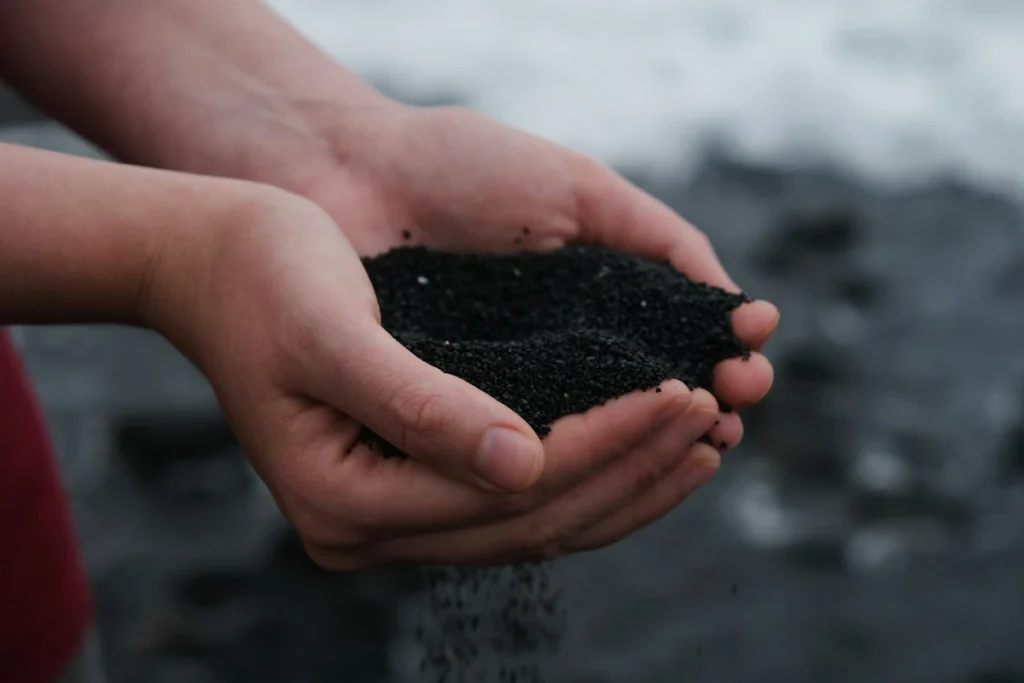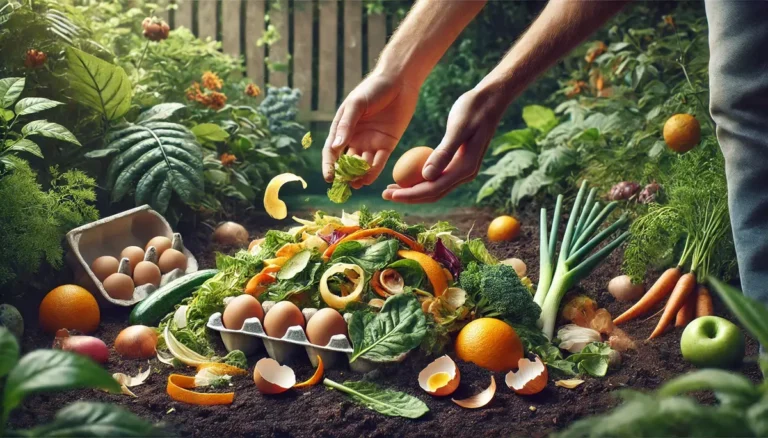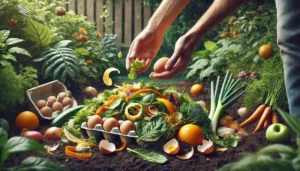Quick Guide to Composting:
- Why Compost? Turn kitchen scraps into garden food, reduce landfill waste, and help the planet.
- What You Need: A bin, food scraps (greens), and dry stuff (browns like leaves or paper).
- How to Do It: Layer greens and browns, keep it damp, and turn it often.
- What to Avoid: No meat, dairy, oily foods, or diseased plants.
- The Reward: Rich, earthy compost for a thriving garden!
Recently, I found myself cooking a meal in the kitchen—a rare activity since cooking isn’t my hobby. As I chopped vegetables and prepared the ingredients, I couldn’t help but notice just how much waste was piling up. It got me thinking—how much waste does a single kitchen generate weekly? The answer is staggering; most of it ends up in landfills or contributes to overflowing waste bins in our cities.
But what if I told you there’s a way to turn these scraps into something incredibly valuable for your garden? Composting is a natural process that transforms kitchen scraps into nutrient-rich compost perfect for your garden.
In this guide, we’ll walk you through everything you need to know about how to make compost from kitchen waste. Let’s turn those scraps into something extraordinary!”
Why Should We Compost Kitchen Waste?
Composting is an eco-friendly habit. It is an effortless and rewarding practice to reduce waste. Every bit of food waste in landfills contributes to greenhouse gas emissions. However, composting turns it into a resource for enriching soil and nurturing plants.
Benefits of Composting Kitchen Waste
- Reduces landfill waste: Composting food scraps helps reduce the burden of landfills. It lowers the emission of greenhouse gases, a significant contributor to climate change.
- Enriches soil naturally: Compost adds essential nutrients like nitrogen and potassium. It acts as a natural fertilizer and you can use it in the garden to improve the quality of the soil.
- Reduces the need for chemical fertilizers: Passionate about eco-friendly gardening? Compost made from kitchen waste lowers the need for chemical fertilizers. It promotes sustainable gardening practices and supports a natural and balanced ecosystem.
- Promotes sustainability: Composting is a step towards a more sustainable lifestyle. It’s a simple practice with a significant impact on the environment. It creates a circular system, turning waste into a valuable resource.
How to Make Compost From Kitchen Waste

Materials Needed for Composting Kitchen Waste
- A compost bin or container
- Green waste (e.g., fruit peels, vegetable scraps)
- Brown waste (e.g., dry leaves, shredded paper)
- A shovel to turn the mixture thoroughly
- Water to maintain moisture levels
Steps to Make Compost from Kitchen Waste at Home
Step 1: Choose Your Composting Method
The first step is to decide on the composting method. Choosing a composting method that suits your lifestyle and space makes the process easier and enjoyable. Here are three common methods:
- Backyard Composting: It is an excellent choice if you have an outdoor garden. You can create an open compost pile or use a compost bin. Open piles are simple but require more attention, while bins keep the process contained and neat.
- Vermicomposting: It is a low-maintenance method; the worms do most of the work for you! It is perfect for small spaces or indoor composting. In this method, worms break down organic waste into nutrient-rich compost.
- Compost Bins or Tumblers: A compact and controlled option for apartment dwellers or those who prefer a cleaner setup. These bins are designed to fit in kitchens and are often odor-resistant, making them a convenient option for beginners.
Step 2: Pick the Perfect Spot
After you have selected the composting method, the next step is to find a perfect spot. The perfect placement of the compost bin ensures consistent decomposition and prevents odors and pests.
Pick a spot that is:
- Shaded: Protects compost from excessive heat or rain.
- Well-ventilated: Ensures proper airflow to speed up decomposition.
- Accessible: Makes it easier to add waste and maintain the pile.
Step 3: Layer the Waste
Layering your compost properly is essential for efficient decomposition.
- Start with a base layer of coarse brown materials like twigs or straw to improve drainage and airflow.
- Add brown waste such as dry leaves or biodegradable paper, which is rich in carbon to feed microorganisms.
- Follow this with a layer of green waste, including fruit peels, vegetable scraps, and coffee grounds, which provide nitrogen to speed up decomposition.
- Alternate layers of brown and green waste, maintaining a 2:1 ratio.
- Sprinkle a thin layer of soil or finished compost over each green layer to reduce odors and introduce beneficial microbes.
This balance prevents unpleasant smells and ensures your compost breaks down efficiently, creating nutrient-rich compost for your garden.
Step 4: Maintain and Monitor
Your compost pile needs regular care to ensure the decomposition process is healthy and productive. Here’s what you should focus on:
Turn the compost regularly. Ideally, every 3–5 days, with the help of a shovel or compost fork. This introduces oxygen, essential for the microbes that break down the waste. Without oxygen, the compost can get compacted and produce a foul smell.
The moisture level in your compost is critical. It should feel like a damp sponge, not too wet or dry. If it’s too dry, add water gradually while mixing. If it’s too moist, add dry materials like shredded cardboard or sawdust to absorb excess moisture.
Step 5: Harvest Your Compost
Once the compost is ready, it will look like dark, crumbly soil with a pleasant earthy smell. Depending on the conditions and materials, this can take two to six months.
To harvest, filter the compost to separate decomposed material from larger pieces of organic material that haven’t broken down. These can be added back to the compost pile for the next cycle.
Store the finished compost in a covered container or use it in your garden. Now you can use this “black gold” to enrich garden soil, boost plant health, and even grow your own organic produce.
What Kind of Kitchen Waste Can Be Composted?
Green Waste
These are rich in nitrogen and include:
- Fruit and vegetable scraps
- Coffee grounds and tea leaves
- Crushed eggshells
Brown Waste
These provide carbon and help balance the compost:
- Dry leaves and twigs
- Cardboard or paper
- Straw or sawdust
Do’s & Don’ts for Composting Success
Do’s
- Break down large food scraps into smaller pieces. Why? Smaller pieces decompose faster because they have more surface area for microbes to work on.
- Always maintain a balance of green waste and brown waste. A proper balance ensures the compost decomposes efficiently without foul odors.
- Stir or turn your compost after every few days to provide airflow and speed up the decomposition process. This aeration prevents bad smells and keeps your compost active and thriving.
- Garden soil, manure, or a compost starter can all help to speed up the decomposition process.
- If pests are a concern, surround your compost bin with fine mesh or chicken wire. This keeps rodents and other critters out.
- Pro tip: A secure lid on your bin also works wonders in preventing unwanted guests.
Don’ts
- Skip adding meat, dairy, or greasy leftovers to your compost. These items attract pests and also create unpleasant odors.
- Never compost plants infected with diseases or weeds carrying seeds.
- Materials like plastic wrappers, glossy paper, or coated cardboard have no place in your compost. They won’t break down and will contaminate your compost.
- Leaving kitchen scraps exposed in an open compost bin can attract flies and other pests. Always cover food waste with a layer of brown waste, like dry leaves or cardboard.
- Don’t let the compost pile dry out. If it lacks moisture, decomposition slows down, and your hard work might go to waste.
Challenges of Composting at Home
1. Odor Problems
Odor issues often arise when the pile has too much moisture or not enough “brown” waste, like dry leaves or paper. To tackle this, layer your food scraps with dry materials to balance the mix. Turning the pile regularly keeps the compost aerated and prevents it from becoming smelly.
2. Pests or Flies
It’s a common frustration, especially if food scraps are left exposed. A simple fix is to cover fresh waste with a layer of brown materials immediately after adding it.
3. Slow Decomposition
Is your compost taking forever to break down? Don’t worry, it is not your fault. Slow decomposition is caused by an imbalance between green and brown materials or insufficient aeration.
4. Time and Effort
Do you feel like composting is time-consuming? Yes, it does take some effort, but it’s simpler than you think. A few minutes each week to check moisture, turn the pile, and add scraps can go a long way.
Conclusion
Composting is a simple way to reduce food waste and enrich your garden. Throughout this guide, we’ve explored how to make compost from kitchen waste, its benefits, and steps to start composting. It helps reduce landfill waste, nourishes soil, and supports a healthier planet.
So, what’s stopping you? Grab a compost bin, save your kitchen waste, and take that first step today. Together, we can turn everyday waste into a powerful tool for a greener tomorrow.
“In nature, nothing is wasted, and everything is transformed.”
– David Suzuki




